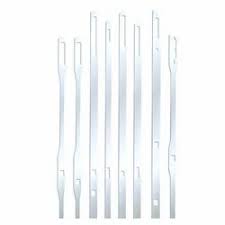
Each heald consists of a frame with one or more eyelets or holes through which the warp yarns are passed. These eyelets are crucial because they allow the warp threads to move in a controlled manner during the weaving process. The heald frame is part of a larger mechanism, often attached to a heald frame shaft. This shaft is moved up and down by the loom's shedding mechanism, which is often controlled by cams or electronic systems. As the heald frame moves, it lifts or lowers the warp threads, creating the shed for the weft yarn to pass through.
Healds are typically made from steel, fiberglass, or synthetic materials like polyester. The choice of material depends on the type of loom, the kind of fabric being produced, and the expected stress on the components. Steel healds are common in high-speed weaving, while fiberglass or synthetic materials may be used in looms designed for finer yarns or delicate fabrics. The durability of healds is important because they undergo continuous movement and friction, which can cause wear and tear over time.
The number of healds used in a loom can vary depending on the complexity of the fabric being produced. For simple woven fabrics, a small number of healds may suffice, but for more intricate patterns such as Jacquard or damask, a greater number of healds may be required. The more healds a loom has, the more complex the patterns it can create. Each heald is associated with a single warp thread, and the precise lifting and lowering of the healds in specific sequences allow for the creation of a wide variety of patterns and textures.
Types of Healds and Their Applications
There are different types of healds used in various weaving applications. Some common types include:
1. Standard Healds
These are the most commonly used type of heald in basic weaving applications. They are typically made from steel wire or synthetic fibers and are designed to handle moderate tension and movement. Standard healds are suitable for weaving fabrics that don't require complex patterns or intricate designs.
2. Jacquard Healds
Used primarily in Jacquard looms, these healds are designed for more complex fabrics that require individual control of each warp thread. Jacquard healds can control specific warp threads for creating intricate patterns like brocades, damasks, and other detailed designs. They are often made from high-strength steel to withstand the higher stresses associated with intricate pattern weaving.
3. Dobby Healds
In looms equipped with a dobby mechanism, the healds are part of a more automated system that allows for a limited variety of pattern control. Dobby healds work in conjunction with a control system that lifts specific warp threads, enabling the creation of small patterns or designs. These healds are typically used in looms producing medium to high-quality fabrics, including patterned textiles like stripes or checks.
We Hope You Find What You are Looking for
Healds are essential components in weaving machines, playing a crucial role in controlling the warp threads during the weaving process. The primary function of a heald is to lift or lower the warp threads (the yarns that run lengthwise in the fabric) to create a "shed" — the opening between the raised and lowered warp threads — where the weft yarn (the yarn that crosses the width of the fabric) passes through. Without healds, the weaving process would be impossible, as they facilitate the orderly and synchronized movement of the warp threads that is required for fabric production.
Frequently Asked Questions






